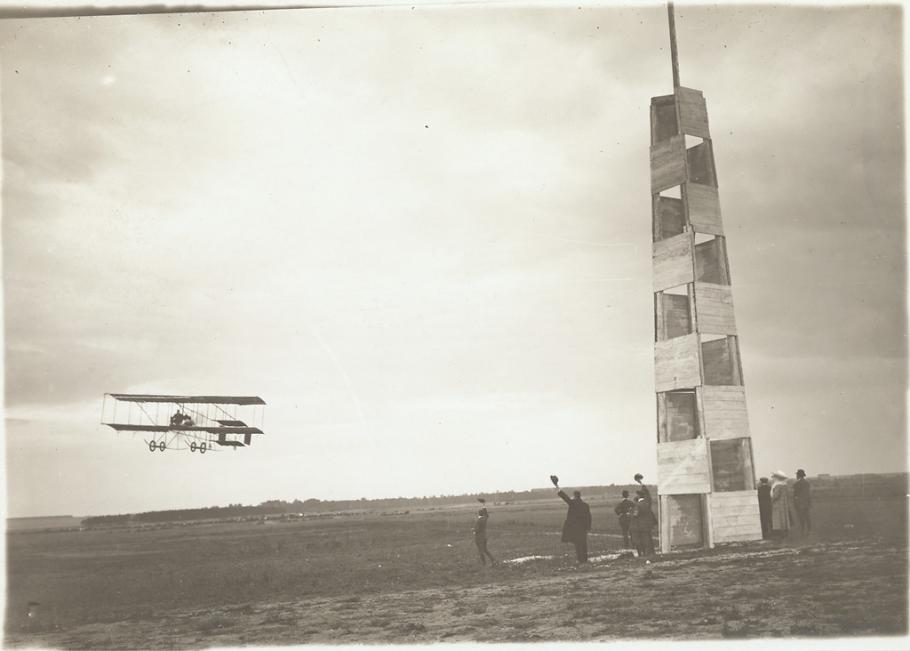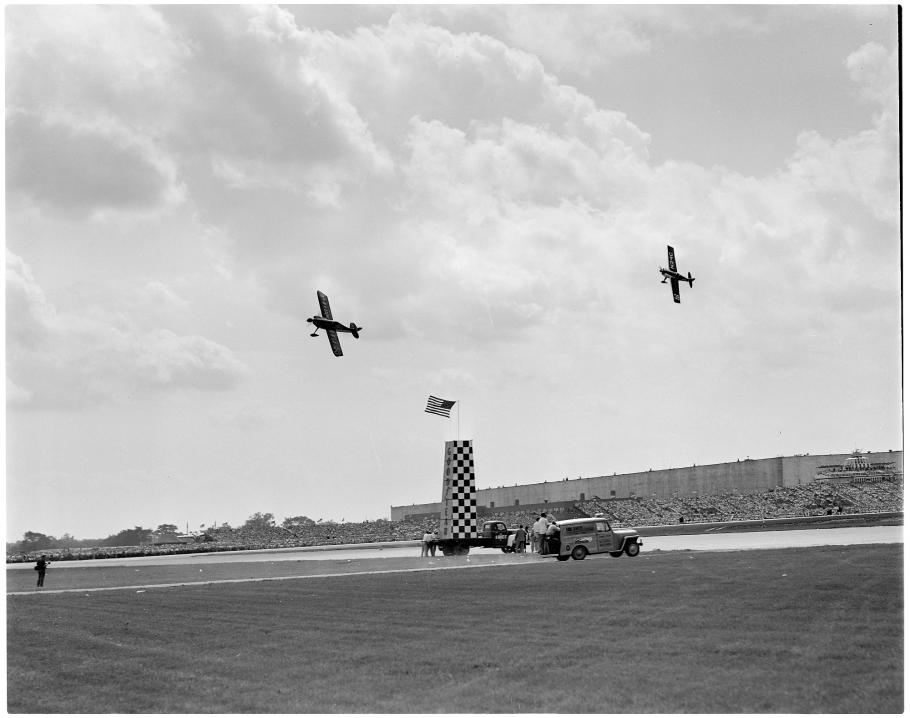The thrill for speed, whether experienced personally or vicariously, runs through American culture. Air racing, in particular, is a motorsport that is as old as aviation itself. Speeding through the sky, Americans have quenched their need for speed for well over a century.
A Farman (Henri) H.F.III type biplane (race no. 32), flown by English aviator George B. Cockburn rounds a pylon during the Prix de Vitesse (Speed Prize) at the Grande Semaine d'Aviation de la Champagne, held at Betheny, Reims, France, August 22-29, 1909.
Daredevil aviators raced their frail contraptions since the early flight era around 1909. After World War I, air racing transformed from an individual to an organized sport. American and European military teams competed for international prestige and the advancement of technology. During the Great Depression, enthusiasts took easily available technologies and built air racers, seeking fame and fortune. Since World War II, the sport has evolved to be ultra-competitive, dominated by purpose-built air racers and heavily modified fighter aircraft.
Air racing comes in different forms of competition. Different types of races sometimes intermingle during competition. For example, there might be a race that is a closed course time trial, or a closed course free-for-all.
Competitors race on a designated track in the sky.
Competitors race against each other.
Competitors race over continents and across oceans.
Competitors race against the clock.
The Conqueror engine installed in the aircraft pictured here represents a long line of successful Curtiss racing engines, and was the last of the Curtiss liquid-cooled engines. The U.S. Navy purchased the engine in 1930 and installed it in this converted monoplane racer. On September 1, 1930, U.S. Marine Corps pilot Captain Arthur H. Page Jr., also pictured, flew the aircraft in the Thompson Trophy Air Race at the National Air Races in Chicago. While leading the field, the aircraft lost power, and Page died during the resulting forced landing.
Notable Air Racing Competitions
National Air Races
Held in different cities in the 1920s, the National Air Races became a high point in American aviation for a given year. They quickly centered on Cleveland, Ohio during the 1930s and after World War II.
Bill Brennand and Wittman Special 20 Buster lead Keith Sorensen and Deer Fly around a pylon during the 1949 Goodyear Trophy Race.
National Championship Air Races
The National Championship Air Races, which began in 1964, are held outside of Reno, Nevada. They host a series of closed-course air races within a wide spectrum of aircraft. As one of the last events of its kind, the races include biplanes, Texan military trainers, jets, Formula One racers, Sport Racers, and the immensely popular, highly modified World War II fighters of the Unlimited Class.
Formula One Air Racing
Formula One began in 1947 to encourage pilots to design, build, and race their own aircraft. Each racer must include design parameters based on weight, wing area, and the use of a fixed-pitched propeller, non-retractable landing gear, and a 100 horsepower Continental O-200 engine. Today, Formula One Races take place around the world.
The 2008 Red Bull Air Race in Budapest.
Red Bull Air Race
Established in 2003, the Red Bull Air Race was an international competition that combined speed and precision. Pilots flew against the clock over an aerial obstacle course.
Notable Figures in Air Racing
Roscoe Turner
There is no excuse for an airplane, unless it will fly fast!
Flamboyant and charismatic, Roscoe Turner was the most famous air racer of the 1930s. During his racing career he won the Thompson Trophy race in 1934, 1938, and 1939, and the Bendix once in 1933. Turner’s fame as a “speed king” transcended aviation into the popular culture of the 1930s. He joined baseball hero Babe Ruth in the popular Sport Kings series of trading cards in 1933, pictured here.
Following his first Thompson Trophy victory in 1934, famed racing pilot Roscoe Turner contracted with the Lawrence W. Brown Aircraft Company to build a new racing aircraft. Designed by Turner and engineered by University of Minnesota professor Howard Barlow, the Turner racer was completed in 1936. Following flight tests, expert builder Matty Laird extensively redesigned the aircraft and added larger wings and flaps.
The modified racer placed third in the 1937 Thompson Trophy event at the National Air Races and won the 1938 and 1939 contests. In 1939, the aircraft was named Miss Champion in recognition of sponsor Champion Spark Plugs.
More Objects Related to Roscoe Turner from the Museum's Collection
Glenn Curtiss
What is the need of racing unless you think you are going to win?
Before achieving fame in aeronautics, Glenn Curtiss started his career with motorcycles. The early aviation community sought out Curtiss because of his reputation for designing powerful, lightweight motor cycle engines. In 1906, he designed his first V-8 engine in response to several requests from early aeronautical experimenters.
Curtiss went on to win the world’s first air race, receiving the Gordon Bennett Trophy at Reims, France, in August 1909. He flew at an average speed of 46.5 mph (74.8 km/h). He became a successful airplane manufacturer and even sponsored a team of pilots.
Objects Related to Glenn Curtiss in the Museum's Collection
Jaqueline Cochran
Jacqueline “Jackie” Cochran learned to fly in 1932, set three major flying records in 1937, and won the prestigious Bendix Race in 1938. She also led women military pilots in World War II. During her lifetime, Cochran held more speed, distance, and altitude records than any other pilot.
Items in the Museum's Collection Related to Jacqueline Cochran
Louise Thaden
Record-setting pilot Louise Thaden captured America's attention during the late 1920s and 1930s. Among other feats, Thaden and co-pilot Blanche Noyes won the Bendix Trophy transcontinental race in 1936, the first year women competed against men for the prize. Thaden made a career in aviation and held several speed, altitude, and endurance records.
Neal Loving
Despite losing both his legs in 1944 while flying for the all-black Civil Air Patrol (CAP), pilot Neal Loving designed and built his first homebuilt airplane. The WR-1 air racer was designed and built in 1950. Loving named it Loving’s Love. His entry into the 1951 Continental Trophy Races at Detroit, Michigan, made him the first African American to participate in air racing.
Objects in the Museum's Collection Related to Neal Loving
Jon and Patricia Sharp
What is my favorite part of air racing? The checkered flag!
Husband and wife duo Jon and Patricia Sharp and their Team Nemesis hold many of the most cherished records in air racing. They’ve claimed speed records on every race course, flown in both the Formula One Nemesis aircraft and the Sport Class Nemesis NXT. Their prestigious pylon racing resumé includes a record 15 Reno Air Racing National Championships, making Sharp the winningest pilot in air racing history.
The most successful aircraft in air racing history, Nemesis dominated its competition, winning 47 of its 50 contests from 1991 until its retirement in 1999. Flown by pilot and co-designer Jon Sharp, it won nine consecutive Reno Gold National Championships and 16 world speed records for its class.
The Nemesis team of Jon Sharp, Cory Bird, Dan Bond, and Steve Ericson achieved several firsts in the design of Formula One racers. They used computer lofting for the shape; custom designed a natural laminar flow wing; built an integrated structure of tooled, pressure molded, carbon reinforced plastics; and incorporated a pilot’s side stick and an on board data acquisition system.
Air Racing Fans
Spectators in the grandstands at the 1949 National Air Races at Cleveland, Ohio.
What would a race be without fans to cheer competitors on? Fans and spectators are a crucial element in understanding the role of motorsports in American culture. Their enthusiasm has fueled professional motorsports and created related industries, such as fan-centric memorabilia.
Section 3 Fans
Led by founder Bob Lewis since 1982, Section 3 is a raucous, fun-loving, and orange-clad group of air racing fans. They’re named after their seating area in the spectator stands at the National Championship Air Races.




